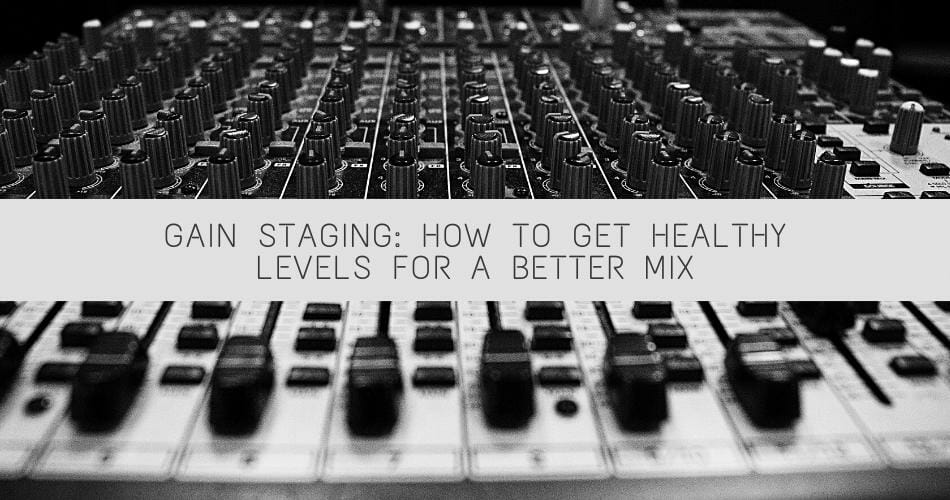Gain Staging: How to Get Healthy Levels for a Better Mix

You’ve likely heard it a thousand times before: Gain staging is really important! When you’re mixing music, you need to leave some headroom!
But what exactly are they? Is there a minimum amount of headroom you require? How do you set up your gain structure to get the best gain staging possible throughout your mix?
Even in the wild new digital world, this simple explanation will help you understand what headroom and gain staging are and why they’re important.
What Is Gain Staging?
When it comes to obtaining a healthy yet clean signal in the good old days of video recording, there were two key factors to consider:
Headroom and noise floor
An engineer’s method of properly travelling between them was good to gain staging. It involved ensuring that the gain structure between devices was properly set up.
It ensured that any device in the signal path received an optimal signal level at its input and that the following device in the chain received an optimal signal level.
The noise floor refers to the signal path’s inherent noise, which includes the recording medium (in those days, it was a magnetic tape).
To optimize your signal-to-noise ratio, you needed to keep your signal as high above the noise level as possible.
“Every recording medium has a finite amount of headroom. If you try to record a signal that’s louder than what the medium is capable of handling, it will clip the tops of the waveform, and you’ll hear that as distortion.”
This meant that quieter parts wouldn’t be masked by hisses and other annoying noise.
The only difficulty with trying to maintain your signal above the noise floor is that you’ve run into another problem: headroom.
What Is Headroom?
Headroom relates to the quantity of space your audio signal has before it becomes compressed and distorted.
Every recording media has a limit on how much headroom it can hold. If you try to record a signal that is stronger than the medium can handle, the tops of the waveform will be cut, resulting in distortion.
Analog circuitry and tape recorders gained headroom over time. When pushed past a specific threshold, a soft compression/saturation effect would appear at first, and the louder the input signal was pushed, the more overt the distortion got.
Engineers would aim to strike the ideal balance between noise at the bottom and distortion at the top, which is what gain staging is all about in the end.
Digital Gain Staging: Perfectly Linear
Many of these gain structure difficulties are solved with digital audio. In most recent DAWs, the noise floor is no longer an issue since system noise is so low that it has no effect on the signal at all.
Also, headroom isn’t an issue. But it’s still important!
We have an ultimate limit in digital (0dBFS, or decibels Full Scale). Any signal that is higher than that will be clipped. However, until that point, digital is a fully linear medium; thus, there is no gradual onset of compression and distortion like there is with traditional recording.
Don’t Stop The Staging
Great. So, why should you care about gaining staging if digital recording appears to have solved all of the problems?
The main reason for this is that every digital chain has at least one (and sometimes two) physical stages (hint: it’s the A in your AD and DA converters).
Your signal must pass through an original stage before being converted to digital when you record. On the way out to your monitors, it must also be converted back to analogue.
These analogue stages suffer from the same gain structure issues as the digital stages:
You’ll be fighting the noise floor if you record too low.
When you record at too high a volume, you risk distortion and clipping.
As a result, when recording, it’s best to keep your levels low. As a general rule, equate -18dBFS to the analogue norm of 0dBVU.
If your peaks aren’t much higher than -10dBFS and your average level is around -18dBFS, you’ll have a signal that’s probably perfect.
Keep in mind that more dynamic instruments, such as drums or percussion, may require more space due to their huge peaks.
Gain Staging For Plugins
When your songs are recorded, the need for effective gain staging does not go away…
Examine all of your plugins, even though you’re in the digital realm. How many are based on old analogue hardware such as compressors, EQs, console channels, tape machines, and so on?
Most of them would display the same “non-linear” behaviour as their standard counterparts if the modelling were done correctly. As a result, the same rules apply: the more you push them, the more they compress, saturate, and distort.
This isn’t usually a negative trait. It can be used for tone shaping in a unique way. However, if you use high levels in all of your plugins, your mix may sound brittle, harsh, and multiple.
So your best bet is to stick to the same approach of optimal gain staging that you used when recording: Aim for a level of -18dBFS as an average.
Maintaining proper gain structure throughout your mix will be easier if you keep it conservative.
Better Gain Staging Means A Better Mix
If you have done everything correctly, your master bus levels should be low enough that clipping won’t be an issue.
As a result, offer headroom and gain staging the care they require. And now you can get on with mixing without worrying about your faders!




